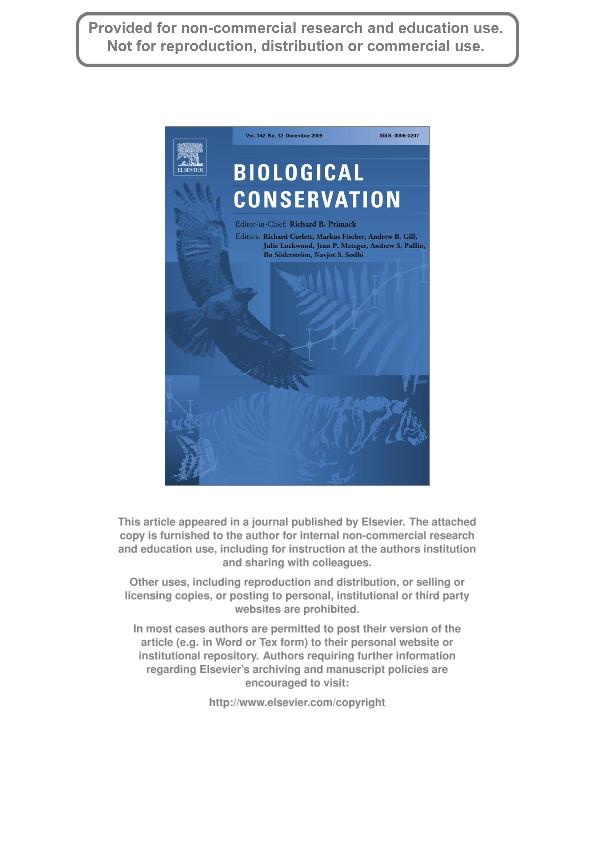Mostrar el registro sencillo del ítem
dc.contributor.author
Tognelli, Marcelo Fabio

dc.contributor.author
Fernandez, Miriam
dc.contributor.author
Marquet, Pablo A.
dc.date.available
2019-06-11T21:21:46Z
dc.date.issued
2009-12
dc.identifier.citation
Tognelli, Marcelo Fabio; Fernandez, Miriam; Marquet, Pablo A.; Assessing the performance of the existing and proposed network of marine protected areas to conserve marine biodiversity in Chile; Elsevier; Biological Conservation; 142; 12; 12-2009; 3147-3153
dc.identifier.issn
0006-3207
dc.identifier.uri
http://hdl.handle.net/11336/78002
dc.description.abstract
The growing concern about the profound influence of human activities on marine ecosystems has been the driving force behind the creation of marine reserves in the last few decades. With almost 4200 km of coastline, Chile has not been the exception to this trend. A set of conservation priority sites has recently been proposed by the Chilean government to expand the current marine reserve network. In this study, we used the most comprehensive information currently available on the distribution of 2513 marine species in Chile to assess the efficiency of the existing system of marine protected areas (MPA) and the conservation priority sites identified by the government. Additionally, we evaluated the vulnerability of the reserve network selected with respect to threatening human activities. Our results show that both the existing protected areas and the proposed priority sites are relatively effective at protecting Chilean marine biodiversity. However, the majority of the species that are not represented within the existing or projected MPA network have very restricted distributions and are, therefore, of high conservation concern. To cover all species requires a network of 35 MPAs (46% of the total number of planning units). Many of the sites identified as irreplaceable present conflict with one or more human activities, particularly in the central region of the country. This study emphasizes the need for a systematic conservation planning approach to maximize the representation of species and prioritize those areas where conflicts between marine biodiversity conservation and human activities may occur.
dc.format
application/pdf
dc.language.iso
eng
dc.publisher
Elsevier

dc.rights
info:eu-repo/semantics/openAccess
dc.rights.uri
https://creativecommons.org/licenses/by-nc-sa/2.5/ar/
dc.subject
Anthropogenic Pressures
dc.subject
Chile
dc.subject
Marine Biodiversity
dc.subject
Priority Sites
dc.subject
Protected Areas
dc.subject
Systematic Conservation Planning
dc.subject.classification
Otras Ciencias Biológicas

dc.subject.classification
Ciencias Biológicas

dc.subject.classification
CIENCIAS NATURALES Y EXACTAS

dc.title
Assessing the performance of the existing and proposed network of marine protected areas to conserve marine biodiversity in Chile
dc.type
info:eu-repo/semantics/article
dc.type
info:ar-repo/semantics/artículo
dc.type
info:eu-repo/semantics/publishedVersion
dc.date.updated
2019-05-06T13:49:16Z
dc.journal.volume
142
dc.journal.number
12
dc.journal.pagination
3147-3153
dc.journal.pais
Países Bajos

dc.journal.ciudad
Amsterdam
dc.description.fil
Fil: Tognelli, Marcelo Fabio. Pontificia Universidad Católica de Chile; Chile. Consejo Nacional de Investigaciones Científicas y Técnicas. Centro Científico Tecnológico Conicet - Mendoza. Instituto Argentino de Investigaciones de las Zonas Áridas. Provincia de Mendoza. Instituto Argentino de Investigaciones de las Zonas Áridas. Universidad Nacional de Cuyo. Instituto Argentino de Investigaciones de las Zonas Áridas; Argentina. University of California at Davis; Estados Unidos
dc.description.fil
Fil: Fernandez, Miriam. Pontificia Universidad Católica de Chile; Chile
dc.description.fil
Fil: Marquet, Pablo A.. Instituto de Ecología y Biodiversidad; Chile
dc.journal.title
Biological Conservation

dc.relation.alternativeid
info:eu-repo/semantics/altIdentifier/doi/http://dx.doi.org/10.1016/j.biocon.2009.08.016
dc.relation.alternativeid
info:eu-repo/semantics/altIdentifier/url/https://www.sciencedirect.com/science/article/pii/S0006320709003954
Archivos asociados
